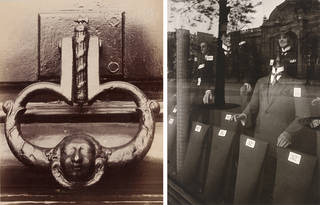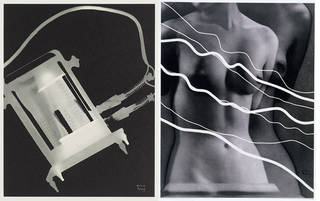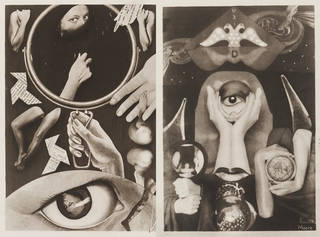Strange shapes, floating body parts and bizarre landscapes: the Surrealists sought to challenge notions of normality through the power of photography.
Surrealism began in the wake of the First World War, when the horror and violence experienced by so many had shifted perceptions of sanity and reality. The movement was immortalised by the French writer André Breton, who published the first Surrealist Manifesto in 1924. This rejected rational ways of seeing the world, looking instead to dreams and the imagination for inspiration. Breton believed that creativity had been weighed down by the drudgery of the day-to-day and sought to release the subconscious power of the dream-like state. Surrealism embraced the absurd, the unconventional, and the shocking.
Surrealist principles presented an exciting challenge for photographers – while a painter can pluck from their imagination with brush and paint, a photograph is derived from the real, material world. Using a variety of processes and techniques such as photomontage (combining diverse photographic images to produce a new work), solarisation (exposing a partially developed photograph to light), and photograms (a cameraless photographic technique), photography soon emerged as a powerful medium for demonstrating Surrealist ideology.

Trailblazers of this approach included canonical figures from the history of photography, such as Man Ray (1890 – 1976), who made photograms depicting household objects which looked more like creatures conjured from the future than simple domestic implements. But Surrealism did not always involve the strange and absurd. For example, the photography of Eugène Atget (1857 – 1927), which focussed on seemingly ordinary sights on the streets of Paris – a door knocker, a mannequin, a window rail – is seen as a forerunner of Surrealist and modern approaches to photography.
Eugène Atget
Only a year before his death, in 1926, Atget was approached by Man Ray for approval to use his photograph, L'Eclipse - Avril 1912 for the front cover of the publication La Révolution Surréaliste. Despite protestations that, "these are simply documents I make", Atget's rejection of artistic self-consciousness combined with his pictures of an old, often hauntingly deserted Paris, appealed to Surrealists. The V&A purchased around 600 photographs from Atget himself for the National Art Library. These were originally destined to be used as reference photographs for students and historians. Today, Atget is admired less as a documentary photographer and more for his modern perspective, which offered a new and at times humorous interpretation of the city.

Man Ray
Man Ray was a successful fashion and portrait photographer, but is most famous for his photograms, which he called 'rayograms'. These are made by placing an object in contact with a photosensitive surface in the dark and exposing both to light. Our collection includes a group of Man Ray's rayograms which were commissioned by the Paris electricity company. One features the female torso of another well-known artist, Lee Miller.

Lee Miller
American artist Lee Miller (1907 – 77) rejected a successful modelling career, moving to Paris in the late 1920s and becoming involved with the Surrealist movement. She is credited with discovering the solarisation process with Man Ray, a darkroom technique which creates partly or wholly reversed tones. Her photograph Exploding Hand (1930) plays with composition and reflections to reimagine an otherwise ordinary scene.

John Havinden
John Havinden (1908 – 87) was a commercial photographer influenced by Surrealism and Modernist ideals. The false starry background combined with the superimposed geometric shapes in Per Annum (1936) suggests a representation of outer space which speaks to Surrealist principles of exploring the subconscious.

Florence Henri
As a child, Florence Henri (1893 – 1982) travelled between relatives in Europe following the death of her mother. She turned to photography after enrolling at the Bauhaus in 1927 where she studied under László Moholy-Nagy, who famously experimented with photograms. Henri often played with mirrors to subvert traditional compositions and question reality. In this still life from the series Mirror Compositions the viewer is unable to distinguish the real object from the reflected.

Claude Cahun
Claude Cahun (1894 – 1954) is the pseudonym of Lucy Schwob, a French artist and writer. She was an active Surrealist, participating in a number of exhibitions including the London International Surrealist Exhibition and Exposition surréaliste d'objets, both in 1936. Best known for her self-portraits, Cahun's work deconstructed traditional concepts of gender and sexuality.

Angus McBean
Angus McBean (1904 – 90) first worked as a mask maker and scenery designer in theatre, the influence of which is clear in his photographs. He became a well-known portrait photographer, capturing the stars of stage and screen such as Vivien Leigh and Audrey Hepburn. He would build sets and stage scenes in his studio to create Surrealist pictures, but also experimented with multiple negatives and dramatic lighting.

Discover more about our Photography and Surrealism collections.
Find out about the Lee Miller archive.


